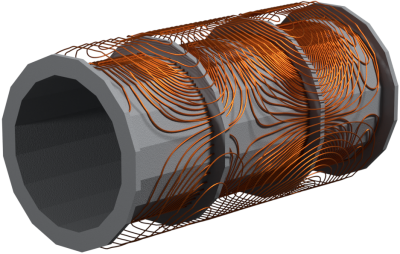Gradient Coil Design Considerations & Limitations Including PNS
Mathias Davids1
1Martinos Center for Biomedical Imaging, United States
1Martinos Center for Biomedical Imaging, United States
Synopsis
Designing an MRI gradient coil is a multi-objective problem that involves a variety of design targets. Aside from the gradient's primary function (generation of a linear gradient field), various other design constraints need to be imposed in order to generate a technically feasible coil geometry. This includes geometric constraints (dimensions of the coil), coil inductance and efficiency, torque/force balancing, wire spacing, Ohmic heating, as well as the overall manufacturability. This talk will give an intuitive overview of state-of-the-art tools for designing MRI gradient coils, including novel designs with reduced interactions with the human body (reduced Peripheral Nerve Stimulation, PNS).
Overview
Designing an MRI gradient coil winding pattern is a multi-objective problem that involves a variety of design goals and constraints. While the gradient coil's primary function is the generation of a linear gradient field (linearly varying Bz component) along one spatial axis, various other design constraints need to be imposed in order to generate a technically feasible coil geometry. These design constraints include geometric constraints (coil length, inner/outer diameter), coil inductance (to allow for rapid switching of the coil, i.e., high slew rate), coil efficiency (large gradient field per unit coil current), balancing of net torque and force resulting from Lorentz forces, Ohmic heating, as well as the overall manufacturability of the coil (only to mention a few). More recently, an additional design constraint has been added to this list: Peripheral Nerve Stimulation (PNS) to maximize the performance space, in which the coil can be safely operated without causing uncomfortable nervous activations (muscle contractions, touch perceptions, or even pain) in the scanned subjects.The Boundary Element Method (BEM) is the Gold-Standard for identifying an optimal solution to this multi-objective problem. The method allows for modeling a continuous current density on a given coil geometry, and also linking this current density to all of the design considerations mentioned above. More importantly, the BEM allows formulating the coil design problem as a convex optimization, that can generate optimal coil winding geometries for a given list of design constraints.
This talk will give an intuitive introduction into the Boundary Element Method, and how this method can be effectively used to design state-of-the-art MRI gradient coils. A special focus will be placed on designing novel geometries with reduced ability to induce PNS.
Detailed list of points covered in this talk:
- The Boundary Element Method (BEM) in gradient coil design
- Finding optimal coil geometries: a Convex Problem
- Impact of different design goals on a gradient coil geometry
- Modeling PNS of gradient coils
- PNS constrained gradient coil design
